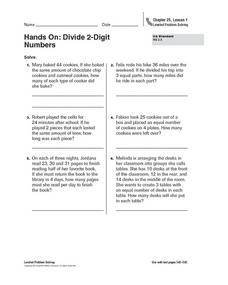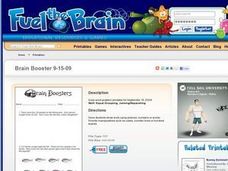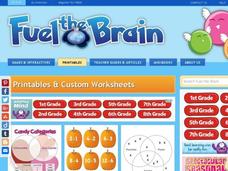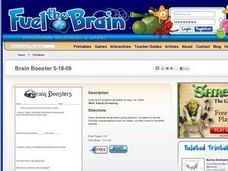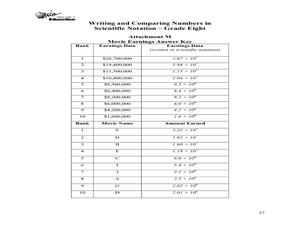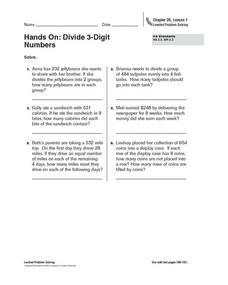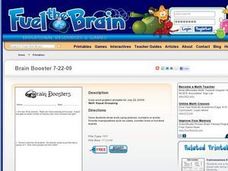Fuel the Brain
Equal Grouping, Number of Groups & Number of Sets
Your class will enjoy solving and illustrating these word problems involving equal grouping of numbers and number sets. Your visual learners will benefit if you provide manipulatives or a hundreds board while solving.
Curated OER
Sharing or Grouping?
In division, word problems often help learners understand the application aspect of the math. By prompting them to label division problems as either grouping or sharing, this worksheet takes a less intimidating and more relatable...
EngageNY
Rational Numbers on the Number Line
Individuals learn how to plot rational numbers on the number line in the sixth instructional activity of a 21-part module. They identify appropriate units and determine opposites of rational numbers.
Curated OER
Equal or Not Equal
Tiny mathematicians count the number of shapes (up to 8) in pairs of object groups and identify the sets as equal or not equal. Five practice problems. They also draw 2 groups of shapes that are not equal. A focused tool that...
Curated OER
Guided Lesson Explanation for More, less, or Equal
How do you teach kindergartners to count? Use this scripted explanation to show pupils how to solve problems that ask them to determine whether the number of objects in one group is greater than, less than, or equal to the number of...
Curated OER
Names for Numbers
In this mathematics worksheet, 1st graders identify various numbers and use counters to illustrate each fact given. Then they complete the math sentences correctly.
Fuel the Brain
Skill: Equal Grouping with Leftovers
Learning to complete word problems can be challenging, especially when the answers can contain leftovers. Through reading, solving, and illustrating each problem, your youngster will understand that answers can contain leftovers.
Curated OER
Hands On: Divide 2-Digit Numbers
In this division worksheet, 4th graders solve 6 story problems in which two digit numbers are divided by single digit divisors.
Curated OER
Equal Grouping, Joining/Separating
Fishing is fun because you can share what you catch. Learners test their addition skills to see how many fish are caught by each person. Another total is given, but all the fish have to be distributed equally. Hope your learners...
EngageNY
Ordering Integers and Other Rational Numbers
Scholars learn to order rational numbers in the seventh lesson in a series of 21. Reasoning about numbers on a number line allows for this ordering.
EngageNY
Ordering Integers and Other Rational Numbers II
Individuals build on prior knowledge to order a set of rational numbers from least to greatest or greatest to least. As part of the lesson, they order rational numbers written in different forms.
EngageNY
The Opposite of a Number's Opposite
It's said that opposites attract, but what about opposites of opposites? Individuals learn about the opposite of opposites using number lines. They complete a group activity in which members determine the opposite of opposites of...
Curated OER
Two Squares are Equal
This problem is sure to get your young mathematicians thinking. The idea sounds simple: one equation, solve it as many ways as you can. This is meant to get at a deeper understanding of solving quadratic equations, including some more...
Illustrative Mathematics
Dividing by One-Half
Understanding when to divide by two or one-half can be confusing. Here is an activity that gives four different scenarios. It is up to your number crunchers to decide if they divide by two or one-half. The easiest way to approach the...
Curated OER
Brain Booster: Equal Grouping, Mixed Problems
In this daily math problem worksheet, students complete three activities that help them equally group and divide numbers. Students show their work using pictures, numbers, or words and may use cubes, number lines or hundred boards for help.
Curated OER
Ones and Tens Place Value
As scholars examine place value, these exercises help them incorporate addition and grouping. First, they answer three missing-addend questions, each with 10 as the given addend. Because all of the missing numbers are single-digit, this...
Curated OER
Los números
A clever way to review numbers in Spanish! First, learners write their phone numbers in Spanish. Then, after writing a series of numbers in Spanish (ranging from 9-1492), they write a group of math problems in Spanish. For example,...
Curated OER
Division with Equal Grouping
Young math wizards solve two story problems in which simple division (with leftovers) is used. They draw pictures or write to explain their answers.
Ohio Department of Education
Writing and Comparing Numbers in Scientific Notation-Grade Eight
Explore scientific notation in this mathematics lesson. Young mathematicians explore multiple representations of large number in scientific notation through the use of models, visual representation and expanded form. The lesson provided...
Curated OER
Hands On: Divide 3-Digit Numbers
In this division worksheet, students solve 6 problems in which three digit numbers are divided by single digit divisors. These are story problems.
Curated OER
Properties of Real Numbers
For this algebra worksheet, students identify and use the properties of real numbers to solve problems. They identify and differentiate between rational and irrational functions. There are 13 problems.
Curated OER
One and Tens Place Value - Step-by-Step Lesson
Give your pupils a grasp of place value in a two-digit number. They see a drawing of counting cubes in a stick of ten, then examine a set of four. Mathematicians determine how many blocks there are by grouping the tens. Ideally, you will...
Curated OER
More or Less...
As they look at 10 groups of shapes, learners compare the A and B columns in this "more or less" activity. Each set includes anywhere from zero to nine shapes, and scholars complete a simple comparative sentence by circling either less...
Fuel the Brain
Equal Grouping
Using division can be challenging for some young learners. However, these problems that are simple division without remainders, are designed to help your learners both conceptualize and visualize the problem before solving.







